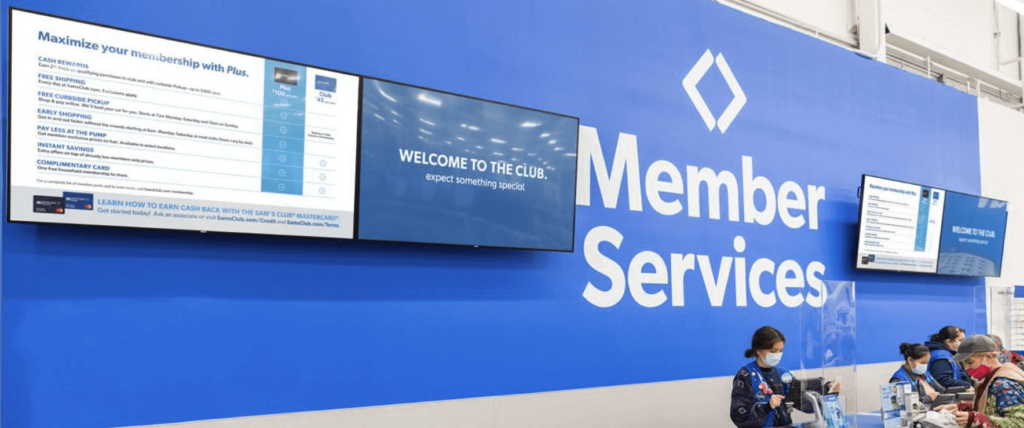Drive Sales and Build Loyalty: How Retail Media Networks Help Brands

Retail media networks allow retailers to monetize their digital properties by selling ad space to third-party brands. Websites, apps, and in-store assets like screens and projectors are all sources of untapped revenue. According to Forrester, one-quarter of retailers are generating more than $100 million in revenue from their media networks. And in the current economy, every little helps.
But it’s not just the additional income proving to be a draw for retail giants like Walmart Inc. or The Dollar General. There are wider benefits of having a retail media network for retail brands, they can also boost brand awareness, improve the in-store shopping experience, and increase customer loyalty.
Learn how Sam’s Club discovered the key to monetizing their digital signage network while delivering on their brand promise.
Wovenmedia’s unique and powerful cloud-based CMS allows Sam’s Club the flexibility they need. Allowing them to meet the expectations of their members and advertising partners across their entire network of 25,000 screens.
Why Are Retail Media Networks Valuable to Brands?
Retail media networks are valuable to brands because they provide an additional revenue stream by monetizing digital screens through advertising and affiliate programs. Retailers can advertise not only their own products, but also those of other relevant brands to their audiences, which can increase outreach and brand awareness.
Many media businesses run campaigns with retailers for greater outreach. Retail media networks allow retailers to create their own media businesses and generate additional revenue streams by selling advertising space on their screens to third-party brands and leveraging their customer data.
The data collected across platforms can give insights into customer demographics and shopping habits. This allows tailoring content and promotions to specific audiences, improving the in-store shopping experience, and increasing customer loyalty. By paying attention to the patterns in their in-store audience, for example, how they change throughout the day and week, retailers can make data-driven decisions that benefit their brand and bottom line.
How Can Retail Media Networks Help Brands Expand Their Reach and Improved Targeting?
Personalized shopping experiences are becoming increasingly important to today’s consumers, with many willing to share personal information for customized deals or offers. With a retail media network, brands can leverage a content management system (CMS) like WovenManager to display targeted ads and improve the in-store customer experience.
WovenManager is designed specifically for use with digital signage and provides flexible content scheduling, allowing for playback across entire networks down to specific locations or individual screens. Brands can tailor their advertising throughout the day/week and in different locations to increase their return on investment. According to a study by Adobe, 89% of marketers see a positive ROI when using personalization in their campaigns.
A top tip for brands looking to diversify their retail media network is to consider more than just store location. Different ads may perform better in different parts of the store, so it’s essential to place screens where people are likely to stop and engage with them. High-dwell areas like kiosks and checkout lanes are popular choices, but non-endemic ads (i.e., sponsored ads) may be more effective in queues, creating opportunities for brands to monetize their retail media network by selling screen space to third-party advertisers.
Find out how to reach shoppers throughout the customer journey using your retail media network.
How Retail Media Networks Matter for Brands: Enhancing the In-Store Shopping Experience and Building Brand Loyalty
1. How do retail media networks help brands deliver personalized content to customers?
Retail media networks can leverage customer data to deliver personalized advertising and promotions that reflect the interests of your audience. By using a content management system (CMS), brands can update their content throughout the day and by location to create a personalized shopping experience that makes customers feel understood by the brand.
That’s the beauty of digital signage. Unlike its traditional counterparts, retailers can update the content with the press of a button during working hours without disrupting the customer journey.
2. Retail media networks create an immersive shopping experience
Ads displayed on digital screens in-store can create a more immersive shopping experience that encourages customers to engage with the content shown. Retail media networks can also bridge the gap between physical and online stores, creating a seamless omnichannel experience that strengthens the brand identity.
3. Retail media networks can be used to promote brands
Retail media networks can be used to promote new products, advertise current promotions or discounts, and showcase brand and loyalty programs. These strategies can encourage repeat custom, increase customer loyalty, and drive sales, ultimately building brand loyalty.
Maximize Your Brand's Impact With a Retail Media Network
Brands can leverage retail media networks to enhance their in-store customer experience, build brand loyalty, and increase ROI. With Wovenmedia’s custom-built CMS, brands can schedule content, manage campaigns, stream targeted ads across their in-store digital screens, and share proof-of-play reports with ad partners. Wovenmedia’s platform empowers brands to diversify their retail media network and maximize their impact with personalized content and immersive shopping experiences.
To learn more about how Wovenmedia can help your brand build a successful retail media network, contact the team or sign up for your free 30-day trial today.
Written by Katy Farmer






